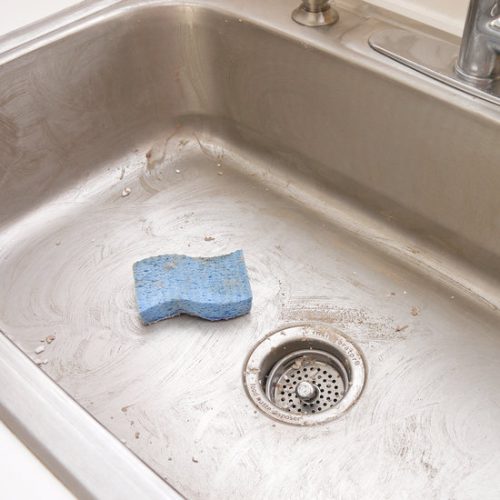Gleaming and shiny, stainless steel brings a bright and polished air to any kitchen. Keeping that brilliant, however, takes a little bit of work-and some very specific cleaning products. Check out the article we found at Fab How.
Things you’ll need:
- Non-abrasive scrubber
- Baking soda
- Vinegar
- Lemon wedges
- Olive oil
- Paper towel
- Old toothbrush
- Dusting cloth or old rag
- Gloves
- Sturdy brush
Step 1. Empty and rinse the sink
Begin the cleaning process by emptying the sink. Remove all dirty dishes as well as food bits from the sink. Then, give the whole sink a quick rinse with hot water. This will help get rid of dirt, loose food particles and other debris.
Step 2. Sprinkle baking soda on the sink
Sprinkle the entire sink with baking soda. Make sure to put the soda on the rim of the sink as well as the faucet. Wait 5 to 10 minutes before moving on to the next step.
Baking soda will help remove light hard-water deposits as well as grease marks from the sink. It also helps to remove stubborn limescale stains. Plus, it will not cause scratch marks on the surface of the steel.
Step 3. Scrub the sink
Once the baking soda has done its work, it’s time to give the sink a nice scrub using a soft scrubber. Instead of scrubbing back and forth, always rub in the direction of the finish of the stainless steel surface.
For stubborn stains that are more noticeable, work in a circular movement to remove the stains and marks. And don’t forget to clean the outside of the sink, too.
After cleaning the sink’s surface, rub the rim as well as the tiles above the sink. These are the most neglected areas that need a good scrub.
Step 4. Use a toothbrush to clean the difficult spots
Put some baking soda on a wet, old toothbrush and use it to clean around the edges and on smaller surfaces. You can use the toothbrush to give the drain opening a nice scrub, too. Then, rinse the entire sink area thoroughly with hot water.
Step 5. Pour white vinegar on the sink
Put a stopper in the drain and pour some distilled white vinegar on the sink. Within seconds you will notice bubbles and fizz. Allow the vinegar to sit for 10 to 15 minutes to do its work.
White vinegar works as a natural disinfectant and its acidic nature helps remove hard-water stains from the surface.
Step 6. Clean with a brush
Next, use a medium-bristled brush to lightly rub the sink. Then, rinse the sink with hot water. Hot water will keep the sink drains clean and free of clogs.
Step 7. Rub the sink with a lemon wedge
Next, use a lemon wedge to rub the entire sink basin. This will deodorize the sink as well as add a shine. Wait 5 minutes before rinsing the entire sink with hot water.
Instead of lemon, you can also use orange or orange peel.
Step 8. Wipe the sink with a dry cloth
To remove the droplets of water left behind after cleaning, use a dry rag to thoroughly wipe down the whole sink. This will prevent water spots.
Step 9. Buff with olive oil
The final step is to buff the surface of the sink with a paper towel and a little bit of olive oil or baby oil. This will help remove streaks and scratches from the surface and keep the sink shiny for several days.
You can even polish the sink with a soft, lint-free cloth. Now, your clean, shiny and germ-free stainless steel sink is all ready for the next use.
Embedded from Fab How
Next Article: 10 Kitchen Tips And Tricks That Everyone Should Know
Read Full Article: How To Clean a Stained Stainless Steel Sink and Make it Sparkle








Peter Rompella
Feb 16. 2017
Like and share this page 🙂 enjoy.
https://www.facebook.com/healthalternativesnaturalherbs/
TCM Healing Secrets
Jun 03. 2017
Worlds best this health info super fan